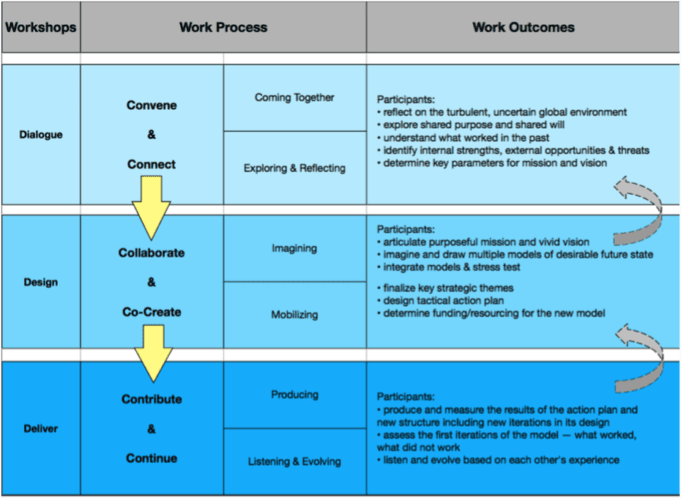Within today’s VUCA (volatile, uncertain, complex and ambiguous) environment that has now become our New Normal experience, many methods for designing and organizing workplaces exist. However, these approaches typically separate rather than integrate the social and technical systems in organizations. Similarly, many ‘fix-the-symptoms’ techniques from exemplar firms have emerged with little real understanding of the design principles that capitalize on —
- connecting talent to • co-create outcomes that • grow and sustain innovative, happy, healthy and humane enterprises.
Instead, we find IT firms implementing collaborative software or groupware into clients’ systems and training these clients on how to effectively operate the software (the technical system) without training those same clients on how to effectively operate in a group or team (the social system).
[M]uch has been made of the likely underperformance of a particularly
high-profile type of collaboration tool — enterprise social networks
(ESNs) — if rollout is conducted without the requisite supporting
behavioral, cultural, and process changes. We forget at our peril that
collaboration is a fundamentally human activity. This implies that any
use of enabling technology without taking into account how people
actually conduct their work, their inclinations to share information
and interact with each other, and in particular how the proposed
technology will empower them and alter their collaborative behavior
for the better/worse, is bound to disappoint.
Dion Hinchcliffe, Enterprise Web 2.0
Collaborative software has a rich history dating back to its founder Doug Engelbart in 1951. In its infancy, it took the form of email, calendaring, text chat and wiki, which emphasized communicating and sharing of content and coined the Internet and Information Age. With the evolution of virtual conferencing and the need to coordinate complex interdependent work, collaboration software migrated into social software ranging from online dating services to social networking sites to digitized collaboration platforms (Google Apps, Microsoft SharePoint, etc.).
Collaboration platforms on the technology side are business-related software that merge social networking capabilities with work processes. More specifically, the expectation is for content, documents, files, conversation and applications to be integrated across the cloud, mobile and social networks. However, as Hinchcliffe states, “the top success factors for a new collaborative technology are typically not technology concerns at all.” His words remind us that a compelling shared purpose, easy connection and interaction and an effective means of flowing information into value exchange and co-creation — the core elements of an effective social system — precede digitizing collaboration. More simply put, if your organization does not know how to collaborate without technology tools, it will not be any more successful with them.
So, why bother learning how to collaborate? Why not stay with the old paradigm of competition? In order to respond to our global iVUCA (interconnected) environment, organizations (and the ecosystems within which they exist) recognize collaboration as necessary for successful innovation. It is becoming increasingly apparent that neither one individual nor one firm has the necessary resources and creativity to both survive and thrive in today’s economy. Furthermore, maintaining a ‘closed’ organizational identity and independence shuts off an organization from new knowledge and resources. The interdependence and interrelatedness emerging within today’s digital footprints and value streams make collaboration possible and essential with current research indicating collaboration is emerging as the standard for organization design.
What organizations are faced with is shifting their cultures and structures from supporting competition to supporting collaboration. This cultural shift necessitates relationship and trust building — a social ‘collaboration platform’ — and is sustained by designing an appropriate structure and technical system that optimize connections and interactions — a socio-tech-environmental ‘collaboration platform’. Designing and organizing from this whole system perspective (social, technical and environmental), connect an organization’s talent so they can uncover source problems and co-create innovative solutions.
The distinguishing proficiency of whole system design is the co-design of humane, open and scalable collaboration platforms organized around mutually beneficial stakeholder value propositions and issue resolution. Its enduring strength is the design of collaboration across —
- sectors (for profit, not for profit, government, industry),
- organizing contexts (individuals/teams, firms, networks, ecosystems), and
- business models.
Collaboration platforms designed from a whole system perspective have clearly defined parameters — a strategic view, organization design elements, socio-technical principles and participative norms (all of which are integrated into a holistic framework easily drawn upon by participants of the platform for their own emergent work designs).
Core Values for Collaboration Platforms
- Human dignity, meaning and community
- Co-creation of our future
- Healthy and beautiful planet
- Healthy and just economy
Guiding Principles for Collaboration Platforms
- Whole systems optimization – people, purpose, planet, prosperity
- Human centered and participative
- Supportive infrastructure and coordination system
- Minimum critical specifications
- Shared governance based on collaborative and emergent leadership
- Genuine partnership based on shared purpose and mutual benefit
- Autonomy and accountability
- Learning and knowledge sharing
- Dynamic, iterative design and mutual adaptation
Core Design Elements for Collaboration Platforms
- Shared Purpose – effectiveness of the platform to attract the necessary participants (the design of incentives, feedback systems, social outcomes, intellectual capital and the use of social media to harness the ‘network’)
- Coordination and Control – ease with which others can ‘plug in’ to connect and interact
- Information Flow – effectiveness of value exchange and co-creation (capturing rich data about participants and leveraging it to facilitate connections)
Finally, this type of collaboration platform engages everyone in the design of the enterprise and/or ecosystem and produces a rich (functional and emotional) collaborative experience for all. The platform jointly optimizes the social, technical and environmental choices currently missing within traditional relationship (trust) building and IT tools.
Below my 6Cs collaboration platform redefines the design process so everyone becomes a designer as they draw upon the minimal critical specifications and practices of humane, healthy and innovative work. The space is provided in which all can stand together to co-develop their specific work contexts, which rapidly shift and change as value emerges from our dynamic environment.
How are you collaborating, personally and professionally, so you can create and contribute from your potential?
Source: STS-RT Adaptive Enterprise Team (Doug Austrom, Don de Guerre, Helen Maupin, Craig McGee, Bernard Mohr, Carolyn Ordowich, Joe Norton)






